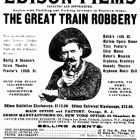Story as Architecture / Architecture as Story
“Think of revision as architecture rather than interior decorating,” my teacher Sonia Pilcer used to tell her Writers’ Block class at the West Side YMCA Writer’s Voice. Narrative as architecture is a useful analogy. Does your story stand on its own? Can its doors open and close? Is it solid or will it fly away at a single wolf’s huff? Better to worry about the structure as a whole before you start thinking about wall paper and sconces.
But what about an architectural story? In a Paris Review interview, Anne Carson discussed how Autobiography of Red, her novel-in-verse retelling of an ancient Greek myth overlaid with a contemporary coming of age story, was architectural:
I think that book is like architecture because the poem, the original ancient poem which does exist, is in the center. But there’s nothing I could do with that, no adequate representation of it I could give, so I made up all these angles for it—the novel itself and the interview and the translation in the preface. So there are ways of moving into and out of a room from other rooms in the building, but really what I want to show is glimpses of that main room in the center.
And, in the anthology My Mother She Killed Me, My Father He Ate Me, Kate Bernheimer called her story “Whitework” a “most architectural story, a Joseph Cornell box or diorama.” Ostensibly set in a cottage in the woods, the story retells Edgar Allan Poe’s “The Oval Portrait”:
The room in which my companion put me to bed was the smallest and least furnished of all. It lay, strangely enough, down a long hallway and up a stairway—I say “strangely” because the house was so diminutive from outside. I realized, upon waking in morning, that I lay in a turret. Yet from outside, no curved wall was visible. With its thatched roof the house resembled a square Christmas package, a gift for a favorite stuffed rabbit—a perfect dollhouse of a cottage, the sort I had painstakingly, as a child, decorated with wallpaper, curtains, and beds.
Bernheimer took her interest in architecture a step further elsewhere, exploring the magical homes depicted in fairy tale via architectural renderings. My favorite is of Borges’s “The Library of Babel”.
Architecture affects how people move through space and relate to one another and is (often) a serious work of the imagination. Kathryn Davis opens her novel Versailles with this epigraph from Jean le Rond d’Alembert: “Architecture is merely the embellishment with which we hide our deepest needs.” Pilcer’s newest work, too, The Last Hotel, is inspired by a “respectable” residential hotel in the 1970s and its solitary residents.
The Prompts
1. Choose a building that fascinates you, whether it is a wonder of the world, a condemned hovel, or some acutely mysterious place. What is the story of this building? Write from the perspective of the building. Remember to use multisensory details, but pay special attention to the olfactory and the tactile. What does the building smell like? Is it airy? Dank? Was it made with love and care? Write fast and don’t stop for at least 10 minutes. Brownie points if you go for 20.
2. Same building, new perspective. Write in the voice of its architect. What are his or her deepest needs? What’s the architect hiding in that building? Go on and write for 10 minutes.
3. Same building, yet another perspective. Imagine two inhabitants in said building. What brings them together? What drives them apart? List each of their desires, fears, habits, flaws. Give them a juicy conflict. How does that building affect their relationship and conflict? Does one of them “win”? What do they “lose” by “winning”? What do they “win” by “losing”? Give yourself a nice fat 20 minutes to start.
4. Do you ever have that dream where you’re walking through a house that continually expands? (I do.) Concoct your own imaginative building. If you need to whet your appetite, look to the series on fairy tale houses. What is your imagined building made of? What is it for? What is its story? Draw it. Write it. Share it with me.
Go on and build the story of your dreams.



